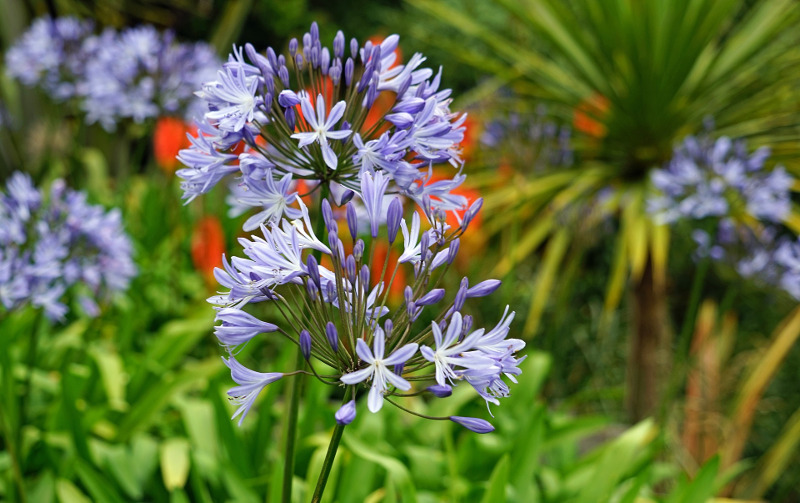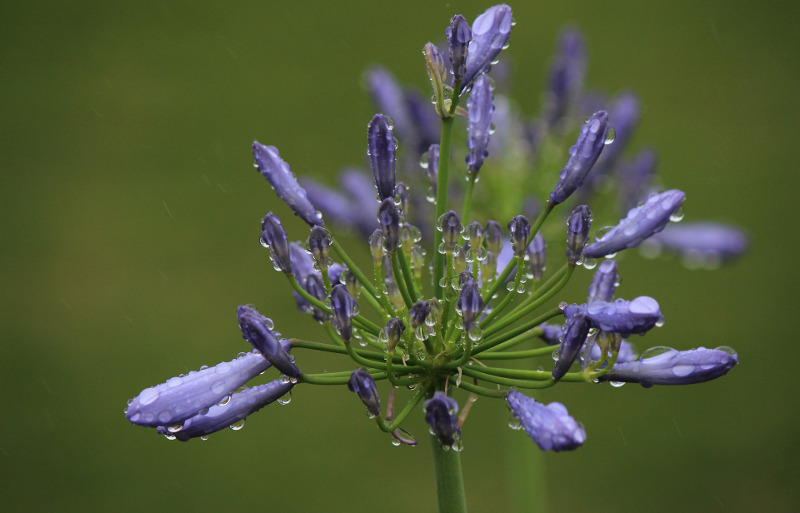These dramatic and elegant showstoppers are native to South Africa but now grow wild in Australia, Great Britain, Mexico, Ethiopia, and Jamaica. In the United States, they are commonly seen in Northern California.

Globes of tubular flowers in shades of blue, purple or white ascend from bold strappy foliage that is similar to a daylily. Sun-loving Agapanthus are also called lilies, as in their common names lily of the Nile and African lily but are not related to true lilies (Lilium species). Instead, they are in the subfamily Agapanthoideae, can be evergreen or deciduous, and are winter hardy in USDA zones 7 through 11, where they look wonderful massed as a border.
In colder zones, they are enjoyed as elegant summer annuals. They range from one foot to five feet tall. They do well as cut flowers and attract pollinators including hummingbirds. It is used medicinally, however the sap can be irritating to the skin or painful if ingested.
Planting Agapanthus
Choose a spot in full sun with well-drained soil. Plant with root crown facing up at least 1” deep or as needed to just cover the roots. In the colder edges of Agapanthus’ hardiness zones, in zones 7 and 8, mulch thickly in winter to protect the roots. Give 8 – 12” of space between plants. Agapanthus bloom the most when pot-bound, so in pots, err on the smaller side for containers. A 12” pot should do for one mature plant.
Watering Agapanthus
Agapanthus will thrive with consistent watering, about 1” a week during spring and summer. The soil should be kept slightly moist but never waterlogged. In fall and winter, allow the soil to dry out.

Fertilizing Agapanthus
In-ground plants will enjoy one light slow-release fertilizer application in spring, or just a top-dressing of compost. Pots should also be fertilized conservatively; overfertilization can cause lanky growth.
Pruning Agapanthus
Maintenance pruning is not necessary. Flowers can be cut to make arrangements. After blooming, allow the foliage to die back naturally rather than cutting it back, then remove once it has yellowed. They can be divided every 4-5 years with a sharp spade or knife.
Caring For Agapanthus in Pots
Choose a 12” pot for a single mature plant, use a well-draining potting mix. Fertilize lightly. They prefer being pot-bound, so wait until absolutely necessary to re-pot. If not hardy in your area, take inside for the winter, treating evergreen types as a houseplant and moving deciduous ones into a cool (but above freezing), dark room to keep dry and dormant. Acclimate to the outdoors after final spring frost.

Winter Care for Agapanthus
If Agapanthus are hardy in your area, consider a thick mulch for the winter to protect the roots, particularly if you are in the colder parts of their hardiness range. If they are not hardy in your area, take them inside for the winter, treating evergreen types as a houseplant and moving deciduous ones into a cool (but above freezing), dark room and keep dry and dormant. Acclimate to the outdoors in spring after final spring frost.
Common Agapanthus Care Questions
Are Agapanthus Drought-Tolerant?
Lily of the Nile (aka Agapanthus) are perennials that make lovely cut flowers and are both heat and drought tolerant.
What Is The Growth Rate For Agapanthus?
In optimal, warm conditions, agapanthus has a moderate to fast growth rate and can reach mature size in just 2 to 3 years.
Do Agapanthus Spread?
Agapanthus does multiply by underground rhizomes which will send up new plants (or by seeding.) These new plants can be separated and transplanted, in fact, thinning and separating every 4 or 5 years will help the plants to remain healthy! Plants created by the rhizomes will be identical to the parent plants, while plants grown from their seeds, may be less desirable for you and your garden. They may be of different sizes, habits, and flower colors! You can stop this if you'd like, by deadheading the spent flowers before they go to seed.
Does Agapanthus Come Back Every Year?
Yes, agapanthus is perennials, coming back every year.
Do Agapanthus Only Flower Once?
Agapanthus will flower repeatedly for several weeks throughout their bloom season and will come back next year and flower again!
What Are Agapanthus Growing Zones?
Agapanthus are considered to be tender perennials and most are hard only in USDA Hardiness Zones 8-10, though some varieties are hardy even to zone 6.
Why Do Agapanthus Leaves Turn Yellow?
Agapanthus leaves turning yellow are most often caused by a chlorosis (iron deficiency in the soil) sun scalding from too much sunlight and not enough water, mealy bug or red spider mites sucking out all the life juices, or fungal disease.
Have a question about Agapanthus? Fill out the form below and we will try and get back to your question as soon as possible. We may even feature your question on this article to help other gardeners!
 |
Author Erica Browne Grivas - Published 06-16-2021 |
